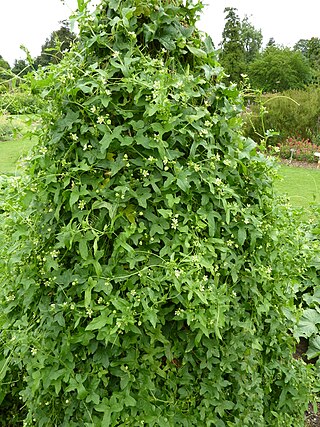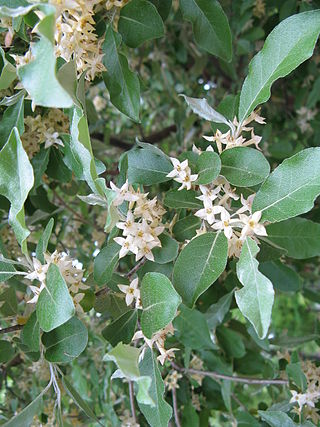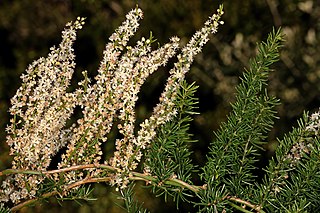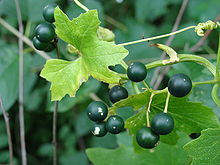
Kudzu, also called Japanese arrowroot or Chinese arrowroot, is a group of climbing, coiling, and trailing deciduous perennial vines native to much of East Asia, Southeast Asia, and some Pacific islands, but invasive in many parts of the world, primarily North America.

Pueraria montana is a species of plant in the botanical family Fabaceae. At least three sub-species are known. It is closely related to other species in the genus Pueraria and the common name kudzu is used for all of these species and hybrids between them. The morphological differences between them are subtle, they can breed with each other, and it appears that introduced kudzu populations in the United States have ancestry from more than one of the species.

Bryonia is a genus of flowering plants in the gourd family. Bryony is its best-known common name. They are native to western Eurasia and adjacent regions, such as North Africa, the Canary Islands and South Asia.

Elaeagnus umbellata is known as Japanese silverberry, umbellata oleaster, autumn olive, autumn elaeagnus, spreading oleaster, autumnberry, or autumn berry. The species is indigenous to eastern Asia and ranges from the Himalayas eastwards to Japan. It is a hardy, aggressive invasive species able to readily colonize barren land, becoming a troublesome plant in the central and northeastern United States and Europe.

Coccinia grandis, the ivy gourd, also known as scarlet gourd, dhendura and kudri, is a tropical vine. It grows primarily in tropical climates and is commonly found in the Indian states where it forms a part of the local cuisine. Coccinia grandis is cooked as a vegetable dish.

Myriophyllum aquaticum is a flowering plant, a vascular dicot, commonly called parrot's-feather and parrot feather watermilfoil.

Polygonum arenastrum, commonly known as equal-leaved knotgrass, is a summer annual flowering plant in the knotweed family Polygonaceae. Other common names include common knotweed, prostrate knotweed, mat grass, oval-leaf knotweed, stone grass, wiregrass, and door weed, as well as many others. It is native to Europe and can be found on other continents as an introduced species and a common noxious weed. Knotweed was first seen in North America in 1809 and is now seen across much of the United States and Canada.

Calystegia sepium is a species of flowering plant in the family Convolvulaceae. It has a subcosmopolitan distribution throughout temperate regions of the North and South hemispheres.

Cucumis myriocarpus, the gooseberry cucumber, gooseberry gourd, paddy melon, Mallee Pear or prickly paddy melon is a prostrate or climbing annual herb native to tropical and southern Africa. It has small, round, yellow-green or green-striped fruit with soft spines, small yellow flowers and deeply lobed, light green leaves. The melon occurs in disturbed soil and cleared or bare areas, and thrives on summer moisture.

Ipomoea cairica is a vining, herbaceous, perennial plant with palmate leaves and large, showy white to lavender flowers. A species of morning glory, it has many common names, including mile-a-minute vine, Messina creeper, Cairo morning glory, coast morning glory and railroad creeper. The species name cairica translates to "from Cairo", the city where this species was first collected.

Araujia sericifera is a perennial vining plant in the genus Araujia, of the family Apocynaceae, that is native to South America. The species was described in 1817 by the Portuguese botanist Félix de Avelar Brotero. The synonym Araujia hortorum is in more frequent use in New Zealand. Its common names include moth plant, white bladderflower, common moth vine, cruel vine, and false choko.

Asparagus aethiopicus, Sprenger's asparagus, is a plant native to the Cape Provinces and the Northern Provinces of South Africa. Often used as an ornamental plant, it is considered an invasive weed in many locations. Asparagus fern, asparagus grass and foxtail fern are common names; however, it is unrelated to true ferns. A. aethiopicus has been confused with A. densiflorus, now regarded as a separate species, so that information about A. aethiopicus will often be found under the name A. densiflorus.

Cuscuta approximata is a species of dodder known by the common name alfalfa dodder. It is native to Eurasia and Africa, but it is also found in North America, where it is an introduced species and uncommon noxious weed. It is a parasitic vine which climbs other plants and takes nutrition directly from them via a haustorium. The dodder resembles a pile of light yellow to orange-red straw wrapped tightly around its host plant. It is mostly stem; the leaves are reduced to scales on the stem's surface, since they are not needed for photosynthesis while the dodder is obtaining nutrients from its host. It bears clusters of tiny yellowish bell-shaped flowers which are only about 3 millimeters wide. The dodder reproduces by seed, with each plant capable of producing over 10,000 seeds at once. This plant is a weed of alfalfa, clover, and tomatoes, as well as other crop plants and native flora. This species is sometimes treated as a subspecies of Cuscuta epithymum.

Vincetoxicum nigrum, a species in the family Apocynaceae, also known as black swallow-wort, Louise's swallow-wort, or black dog-strangling vine, is a species of plant that is native to Europe and is found primarily in Italy, France, Portugal, and Spain. It is an invasive plant species in the northeastern United States, parts of the Midwest, southeastern Canada, and California. In 2020, wild plants were found in Timaru, New Zealand.

Lonicera tatarica is a species of honeysuckle known by the common name Tatarian honeysuckle. Native to Eurasia, the plant is one of several exotic bush honeysuckles present in North America, being considered an invasive species there.

Cardiospermum halicacabum, known as the lesser balloon vine, balloon plant or love in a puff, is a climbing plant widely distributed across tropical and subtropical areas of Africa, Australia, and North America that is often found as a weed along roads and rivers.

Bryonia dioica, known by the common names red bryony and white bryony, also English mandrake or ladies' seal, is a perennial climbing vine indigenous to Central and Southern Europe. It is a flowering plant in the cucumber family Cucurbitaceae with five-pointed leaves and blue or white flowers. The vine produces a red berry fruit.

Kudzu is an invasive plant species in the United States, introduced from Asia with devastating environmental consequences, earning it the nickname "the vine that ate the South". It has been spreading rapidly in the Southern United States, "easily outpacing the use of herbicide, spraying, and mowing, as well increasing the costs of these controls by $6 million annually". Estimates of the vine's spread vary, from the United States Forest Service's 2015 estimate of 2,500 acres per year to the Department of Agriculture's estimate of as much as 150,000 acres annually.

Solanum tampicense, also known as wetland nightshade, aquatic soda apple, and scrambling nightshade, is a perennial in the Solanaceae or Nightshade Family. It can exist as a vine, tree, or shrub and is native to the West Indies and Central America. It is classified as a noxious weed by the United States Department of Agriculture and by several states and is known as an invasive species in the state of Florida.

Pueraria tuberosa, commonly known as kudzu, Indian kudzu, or Nepalese kudzu, Vidarikand, Sanskrit: Bhukushmandi (भूकुशमंडी) is a climber with woody tuberculated stem. It is a climbing, coiling and trailing vine with large tuberous roots. The tubers are globose or pot-like, about 25 centimetres (9.8 in) across and the insides are white, starchy and mildly sweet. Leaves are trifoliate and alternate, while the leaflets are egg-shaped, with round base and unequal sides. They are 18 cm (7.1 in) long and 16 cm (6.3 in) wide and are hairless above. Flowers are bisexual, around 1.5 cm (0.59 in) across and blue or purplish-blue in color. The fruit pods are linear, about 2–5 cm (0.79–1.97 in) long and constricted densely between the seeds. They have silky, bristly reddish-brown hair. Seeds vary from 3 to 6 in number.



















